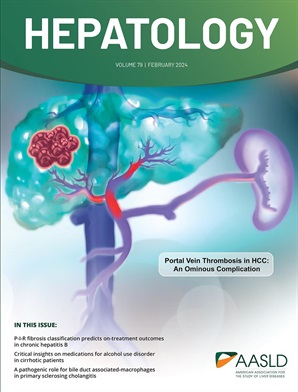口服 LPCN 1148 可改善男性肝硬化患者的肌少症和肝性脑病:随机安慰剂对照 2 期试验
IF 12.9
1区 医学
Q1 GASTROENTEROLOGY & HEPATOLOGY
引用次数: 0
摘要
背景& 目的:肌肉疏松症在肝硬化患者中非常普遍,并与包括肝性脑病(HE)在内的不良临床结果有关。雄激素受体激动剂(ARA)可通过多模式作用机制解决这些问题,但其在肝硬化患者中的安全性和有效性尚未得到充分证实。方法与amp; 结果:在这项多中心、双盲、2 期试验中,患有肌肉疏松症和肝硬化并等待肝移植的男性患者按 1:1 的比例随机接受口服 ARA LPCN 1148 或安慰剂治疗 24 周(NCT04874350)。主要终点是通过L3区域计算机断层扫描测量的骨骼肌指数(L3-SMI)从基线到24周的变化,并对预设的修正意向治疗人群进行分析。次要终点是明显 HE 事件的数量。29名参与者(平均年龄=59岁,MELD=17)接受了至少一剂LPCN 1148(15人)或安慰剂(14人)。各组的基线特征相似。主要终点分析表明,与安慰剂组(10 人)相比,LPCN 1148 组(15 人)的 L3-SMI 有所增加,平均组间差异为 4.4 cm2/m2(95% CI,1.3-7.4 cm2/m2,p=0.007)。与安慰剂相比,LPCN 1148 参与者发生明显 HE(CTCAE 分级≥2;p=0.02)的次数更少。两组患者在治疗过程中出现的不良反应次数和严重程度相似。结论LPCN 1148 治疗可改善患有肝硬化和肌肉疏松症并等待肝移植的男性患者的肌肉疏松症,并减少明显 HE 的发作次数。这些发现支持对 LPCN 1148 治疗肌肉疏松症和预防 HE 复发的疗效进行更多研究。本文章由计算机程序翻译,如有差异,请以英文原文为准。
Oral LPCN 1148 improves sarcopenia and hepatic encephalopathy in male patients with cirrhosis: A randomized, placebo-controlled phase 2 trial
Background & Aims: Sarcopenia is highly prevalent in patients with liver cirrhosis and is associated with adverse clinical outcomes including hepatic encephalopathy (HE). Androgen receptor agonists, ARAs, can address these conditions through multimodal mechanisms of action, however their safety and efficacy in patients with cirrhosis have not been well established. Approach & Results: In this multicenter, double-blind, phase 2 trial, men with sarcopenia and cirrhosis awaiting liver transplant were randomized 1:1 to receive either oral ARA LPCN 1148 or placebo for 24 weeks (NCT04874350). The primary endpoint was the change from baseline to 24 weeks in skeletal muscle index measured by computed tomography scan of the L3 region (L3-SMI), analyzed with a prespecified modified intent-to-treat population. The secondary endpoint was the number of overt HE events. 29 participants (mean age=59 y, MELD=17) received at least one dose of LPCN 1148 (n=15) or placebo (n=14). Baseline characteristics were similar between groups. Primary endpoint analysis demonstrated an increase in L3-SMI in the LPCN 1148 group (n=15) compared to placebo (n=10), with a mean group difference of 4.4 cm2 /m2 (95% CI, 1.3-7.4 cm2 /m2 , p =0.007). Participants in LPCN 1148 experienced fewer episodes of overt HE (CTCAE grade ≥2; p =0.02) than placebo. The number and severity of treatment-emergent adverse events were similar between arms. Conclusions: LPCN 1148 treatment improved sarcopenia and reduced the number of overt HE episodes in men with cirrhosis and sarcopenia awaiting liver transplant. These findings support additional research on the efficacy of LPCN 1148 in treating sarcopenia and preventing HE recurrence.
求助全文
通过发布文献求助,成功后即可免费获取论文全文。
去求助
来源期刊

Hepatology
医学-胃肠肝病学
CiteScore
27.50
自引率
3.70%
发文量
609
审稿时长
1 months
期刊介绍:
HEPATOLOGY is recognized as the leading publication in the field of liver disease. It features original, peer-reviewed articles covering various aspects of liver structure, function, and disease. The journal's distinguished Editorial Board carefully selects the best articles each month, focusing on topics including immunology, chronic hepatitis, viral hepatitis, cirrhosis, genetic and metabolic liver diseases, liver cancer, and drug metabolism.
 求助内容:
求助内容: 应助结果提醒方式:
应助结果提醒方式:


